Makers 1-on-1 is our original interview series featuring today's makers and DIYers. We're sitting down with new makers every week to learn more about their projects, how they acquire information, their purchase processes, and their passions.
This week, we’re interviewing Madeline Mehler, the leather crafter and sewist from Erie, PA, behind Sultrie leather accessories. While studying fashion design, Madeline began creating patterns and sewing unique leather bags for herself and others. She uses strong leather and fabrics, hardware like eyelets and D-rings, and sewing machines and tools to put it all together. If your brand sells to designers and makers who sew, this 1-on-1 interview with Madeline will give you some important insights into connecting with makers like her.
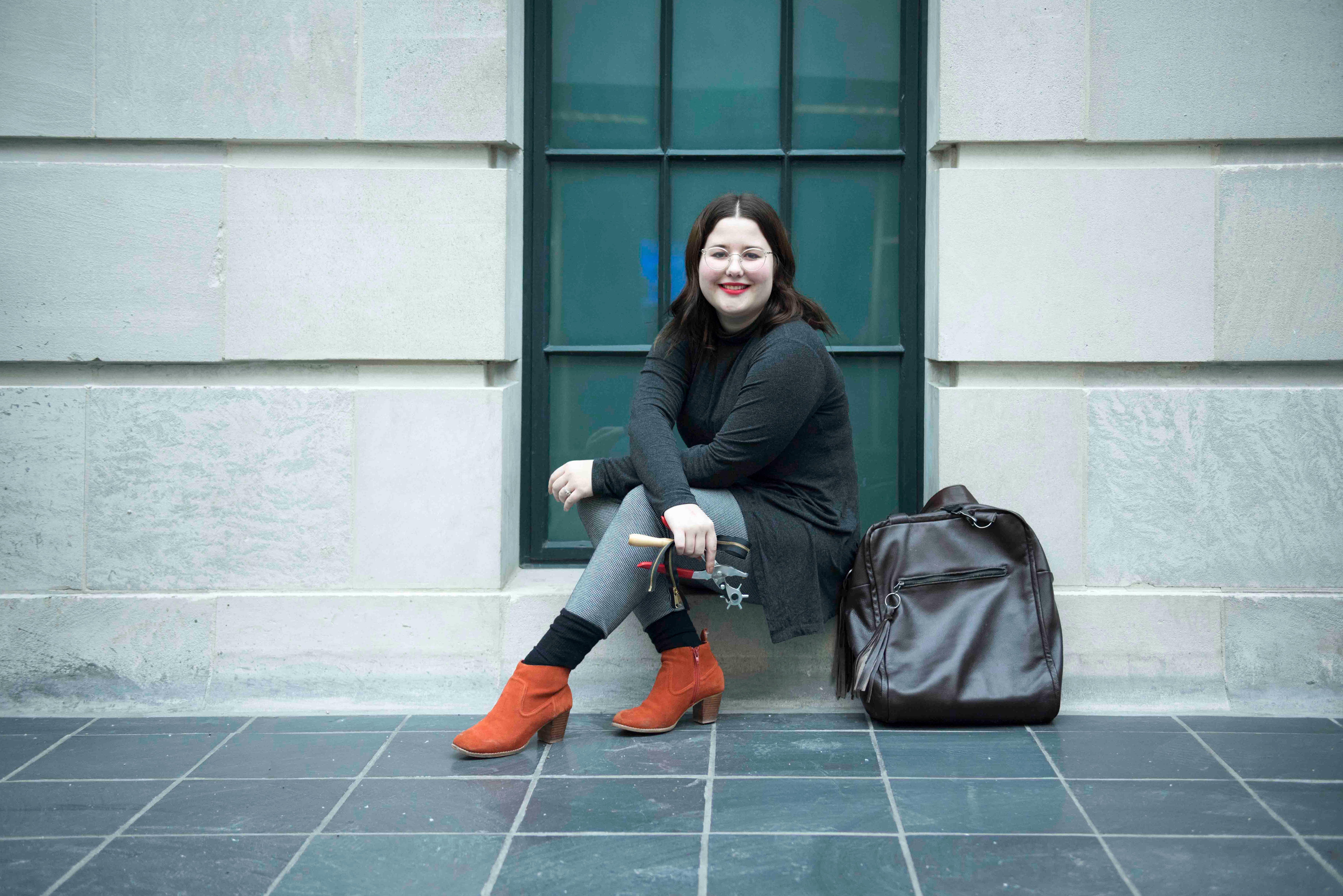
What's your name and what do you do?
I am Madeline Mehler, I’m from Erie, Pennsylvania, but I go to school at Kent State for fashion design and I’m also getting a minor in business, and I kind of come from a family of entrepreneur women, which is really cool. My grandmother started a florist company in Akron, Pam’s Posies. They have two locations in Akron and Pam is my grandmother. Then my mom owns a cooking school. On my dad’s side of the family, they’re all tailors. My dad’s an attorney, but his father and grandfather were tailors and owned a shop in my hometown. So I come from a very creative, entrepreneurial background.
When I graduated high school, I knew I was going into fashion design, and I knew I wanted to occupy my time with my own personal projects, and I knew I wanted to make money with it, so I started Sultrie in the summer of 2015.
How did you get started sewing and designing?
It actually did not start out as accessories at all; it started out as odds and ends, do-it-yourself sewing projects that I would do, cute little wrap scarves and bathing suit cover-ups and random little things that I could make. I used a lot of recycled materials. I would go to Goodwill and buy bedsheets to use as fabric because they were large expanses of material that was really, really cheap. It started out like that, and then I started at Kent State and things got really busy, so my direction kind of changed as I started to learn more about the industry.
The next summer, I rebranded, and I wanted to do something more organized in terms of products I was designing and releasing. I had always been attracted to the idea of made-to-order products because I think that, as a student, it’s a lot easier to know what to manufacture. You don’t have to spend money on inventory; you only spend money when someone is saying, “I want to buy this.” But the problem was that the garments that I designed—people wanted to take them right off the racks. So that was really hard for me because I would do craft shows and pop up shops in Kent and people would say, “I love this, but I want to take it home now instead of doing made-to-order,” so I saw a lot of disappointment there.
I was talking to my mentor back home who owns a vintage boutique, and she was saying, “You should do what you’ve always done best. Since you were little, you’ve been making bags.” That’s how I started out sewing; I was making myself pencil cases and makeup bags and cutesy purses for my mom and things like that. When I was in high school, I made my backpack for school every year. I just loved that because it was this product that you can be 19 or 90 years old and have an interest in an accessory. It doesn’t have to be male, female, old, young. There’s a lot broader of a consumer that I can tailor to.
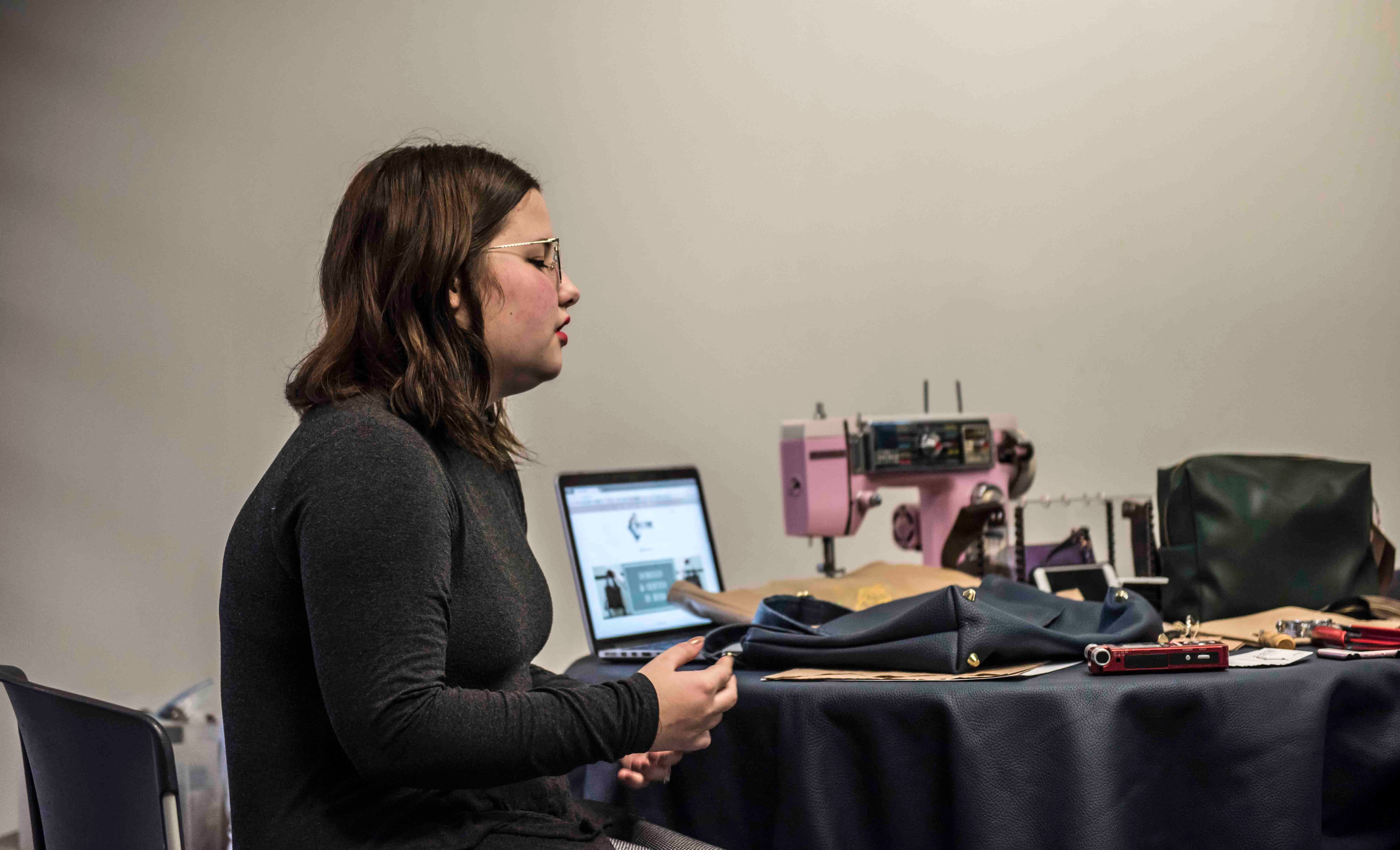
What steps go into creating one bag?
When I think about it in my head, I have to be thinking 2D and 3D at the same time. What I did is I designed this pattern online. I imagined this shape in my head, and what I really like to do is create bags that are only one pattern piece. They fold up easier and look at lot more clean and geometric, so that was something I adopted early on. I create this pattern digitally and then I send it to the textile lab upstairs, and they have a laser cutter. I just put craft paper through it, and it’s perfect to all my measurements and requires no tedious cutting. Then I lay this down on my leather and trace it with a pen because you cant really pin a pattern piece to leather, then I cut it out and sew it up. That’s pretty much how its been going.
I have two facets to this business: the products I design on my own and people can buy right off the rack, and then another part where people have been coming to me in the last six months and saying, “I have this bag that I love, but it’s gross and i need to get a new one. I love this function that the bag serves for me and I want something that’s the same, but just updated.” So I have a consultation, and ask what kinds of things they’re looking for, how many pockets, where and how big, do you need to fit a laptop, a cell phone, and iPad, a camera. Then we talk about hardware color, and then leather color too, and by the end of it they have a custom bag. It’s really cool because I get to put my own spin on it but I also get to see somebody have something that’s person to them.
Where do you show off your work?
I’m part of an organization on campus called LaunchNET, and it’s basically an office for student entrepreneurs. They have a lot of events where I’ve been able to sell in person. I’ll also go to whatever shows I can find that are at a reasonable price for a student. The big shows and conventions can be hundreds of dollars, and that’s crazy for me because I don’t have enough inventory to keep up with that. But over the summer, I did a lot in my hometown because there’s a strong small business community there. I could do three or four events for about $50 apiece. I made my money back because I sold my most expensive bag on the table.
How do you choose the materials you use?
I took an interest in leather craft because it’s such a highly coveted material in the fashion industry, and it’s such a pure and strong and natural material, so I bought a bunch of books and I read a lot online, and I made my first leather bag.
I don’t have a budget to be buying wholesale, and leather is really expensive: it runs from $100-$400 for a hide. I have this little gem in my hometown; it’s a fabric store, and they basically go to trade shows and they buy the last of the stuff that these wholesalers can’t sell. So they sell it in their remnants store for really, really cheap, and that’s where I’ve gotten most of my leathers. However, this navy leather I brought back from Italy when I was there. I thought this navy color was so unique; we usually just see black and brown and red. I actually have had great luck with finding hides at decent prices. The first hide I found was a deep chocolate brown—what most of these bags are made out of—and it was only $70. I got about six bags out of it.
Right now, I’m going to JoAnn’s and Hobby Lobby for hardware because they pretty much have the same brands, but my next step is finding suppliers that are a lot cheaper. So my uncle is still a freelance tailor and alterations maker, and he has a supply book, and he had me look through it and go to their website and see if I could find what I need. So I’m in the process of researching this right now, but the problem is buying in wholesale and bulk; that’s so scary because I don’t know if I’ll make money off it.
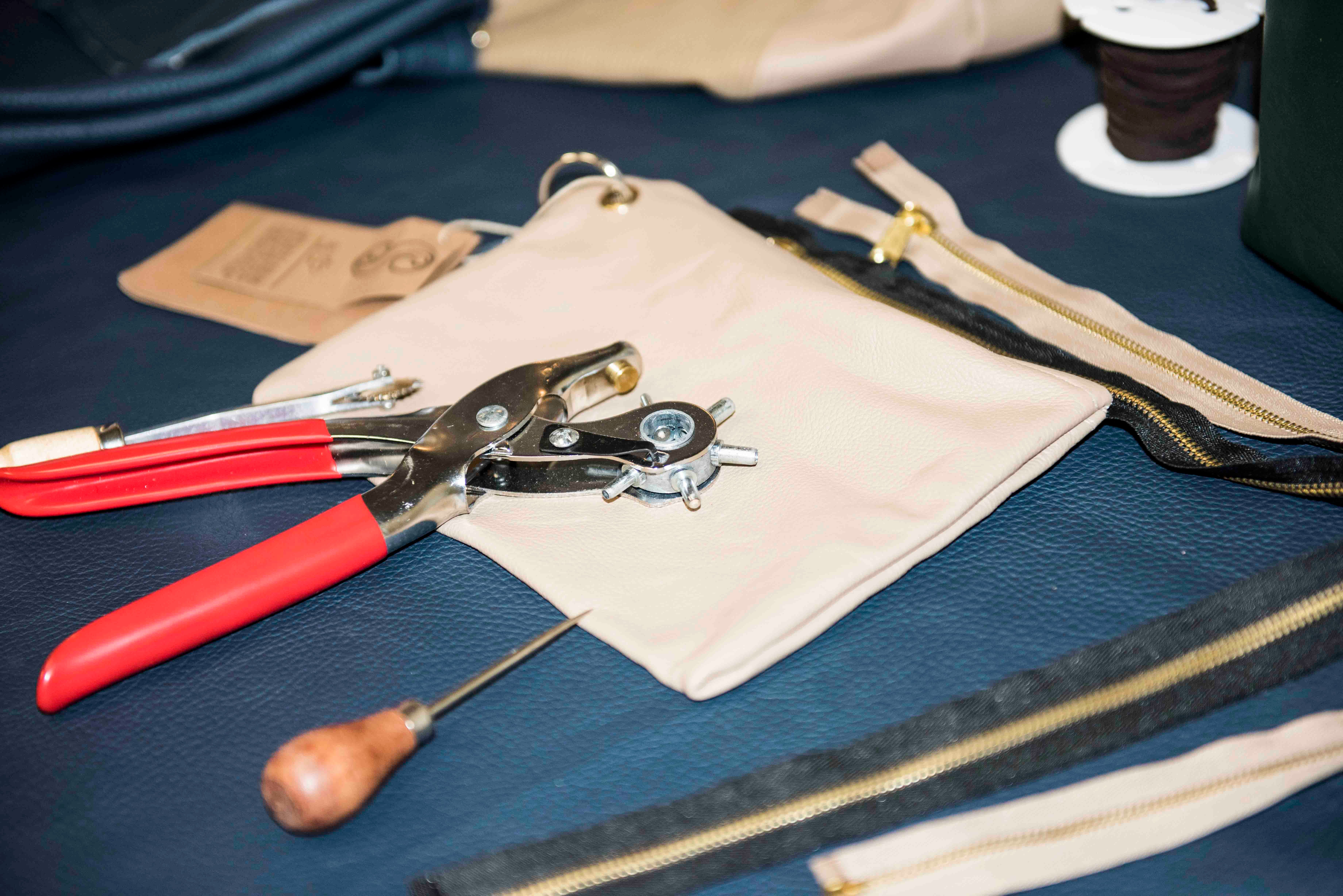
Where do you gather information and research your craft?
It’s a little all over the place. I have a lot of books on my actual craft, but in terms of business research, I’ve had to do my own things. I’ve been through Etsy, and Shopify, and you can have a Wix site or Squarespace—so trying to research all of that kind of came with my job at LaunchNET. It was about researching tools for small business owners. And my mom has had a lot of experience with bookkeeping, so she was able to help me a lot with bookkeeping skills and organization. It’s a hodge podge of information.
What social media are you active on?
I’m on Instagram and Facebook the most. Instagram would probably be my number one because I have seen a lot of small businesses in my hometown get their momentum with Instagram. My biggest issue right now is photography. I’m a designer but not a photographer. So my Instagram needs a lot of help right now, but it’s my favorite to use because I feel like everyone who has a really well-off business—their Instagram is so pretty. Facebook is definitely where I gravitate to in terms of finding people who are putting on these events. There are a lot of Facebook groups for crafters in the county and things like that.
Where do you get inspiration for designing?
Everywhere. When I was in Italy, my eyes were glued to all the of displays and how bags are merchandised. Dior released a video in the last year showing how they hand-painted their leather bags and the process of putting them together, and that in itself is inspiring. It’s beautiful craftsmanship. I think a lot about geometry. I feel like my bags have a lot of architectural shapes. And a bag is a 3D form that has to support itself, whereas like a dress can lay flat because the form is the body. I look at people coming up with crazy stuff nowadays for shapes of handbags: bags that are built into a dress, or a fanny pack on a metal hoop, but it’s everywhere.
How do you manage your time as a student designer?
It’s really tough, honestly. And I definitely had to take a hiatus when I studied abroad. It can be really tough but I try to make this my extra curricular. This is a point on my resume; I have my own business. In the past I’ve wanted to join clubs or take ballet, but it’s all about priorities. And I didn’t think this was going to be my priority until I saw the success that I’ve had. It’s hard, but people do it, and now that I’ve seen people that actually want to buy what I’m making, it’s all the empowerment that I need.
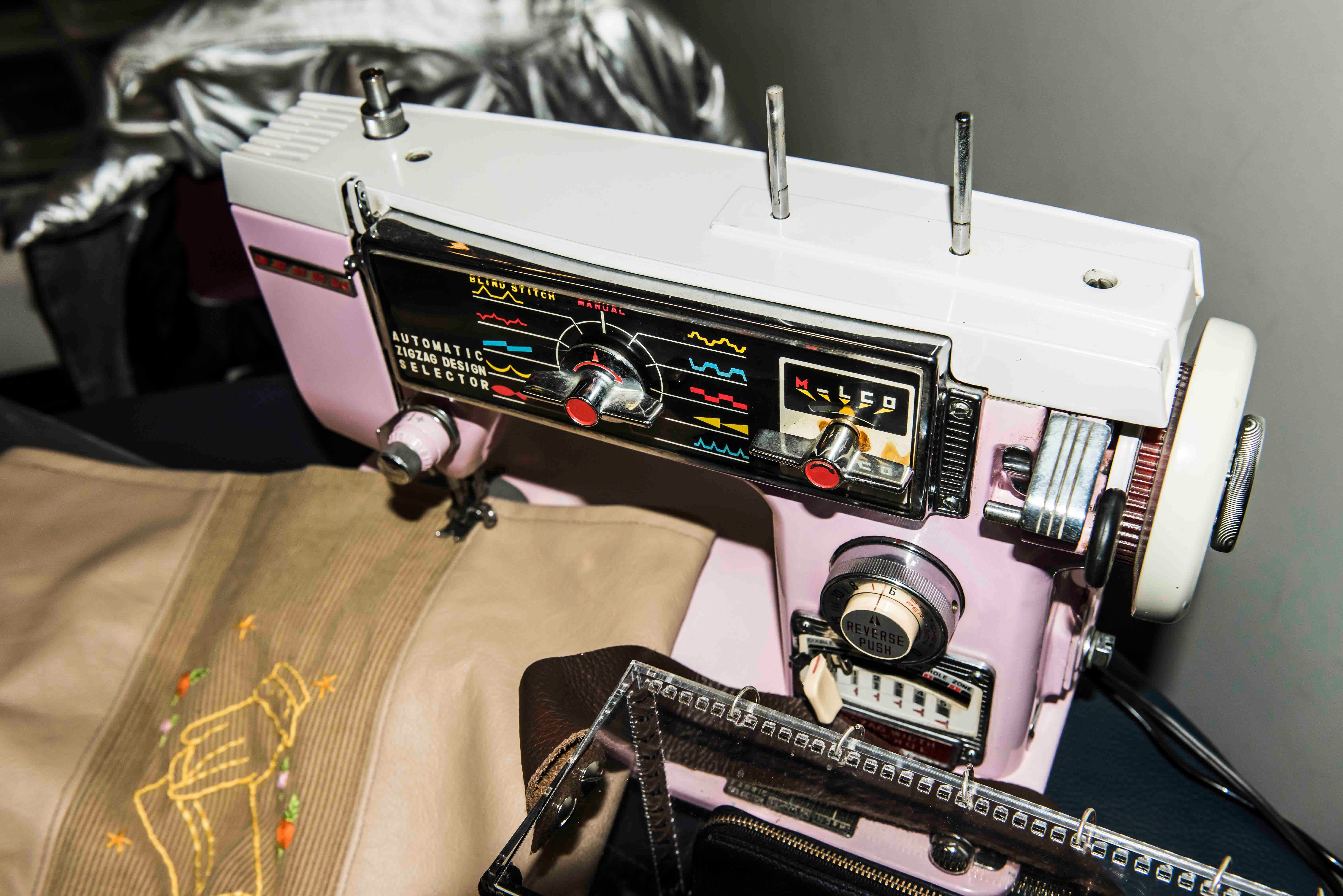
How much time, on average, does it take to make a bag?
Some might take 45 minutes—not that long at all. But for commissions, like one I’ve done for my cousin with two pockets and an interior pocket, it takes probably about five to eight hours, usually over a few days. That’s mostly because this was a new design, so I had to pattern it out and figure out the mechanics of how all the pieces would fit together, and I also had to go shopping for more stuff in between.
What's the most rewarding part of what you do?
I’d say it’s seeing things that are in your head, thinking about all the ways these ideas can flesh out and be successful, and then you go through the process of actually bringing that idea to life. Then you see someone who actually wants to take that thing home and make it part of their personal routine: that’s probably the most rewarding thing.
How have you found support in the maker community?
Small businesses with handmade products especially are always supportive of each other. For instance, I know another girl named Anne at LaunchNET that does accessories too, but they are skyline themed (see our interview with Anne Cate here!)—but even though we’re competing a little bit, I’ve felt that she and I have been really supportive of each other. She bought one of my products, and it’s so nice to see that support. I find this community, especially of young people, to be much more supportive than catty. You’ll make it further by supporting people than by pushing yourself ahead.
What motivates you to continue making handbags?
That’s a really good question because I feel like as an artist, you get the momentum when you’re really excited about a project and then when it doesn’t go exactly how you wanted it to, you end up leaving it without finishing. That’s a struggle that I’ve had—not finishing projects like this. But I’m really proud that I’ve been able to take it this far. I released my line of leather bags this summer, and by the end, they’d all sold out. And I’ve had a bit of a jump start with my education. Even skills like pattern making—it’s obviously very different from making patterns for a body, but the major concepts are the same. So knowing that I have that kind of knowledge on my side, and knowing that I can make a formulated business plan from the classes that I take, gives me a great cushion.
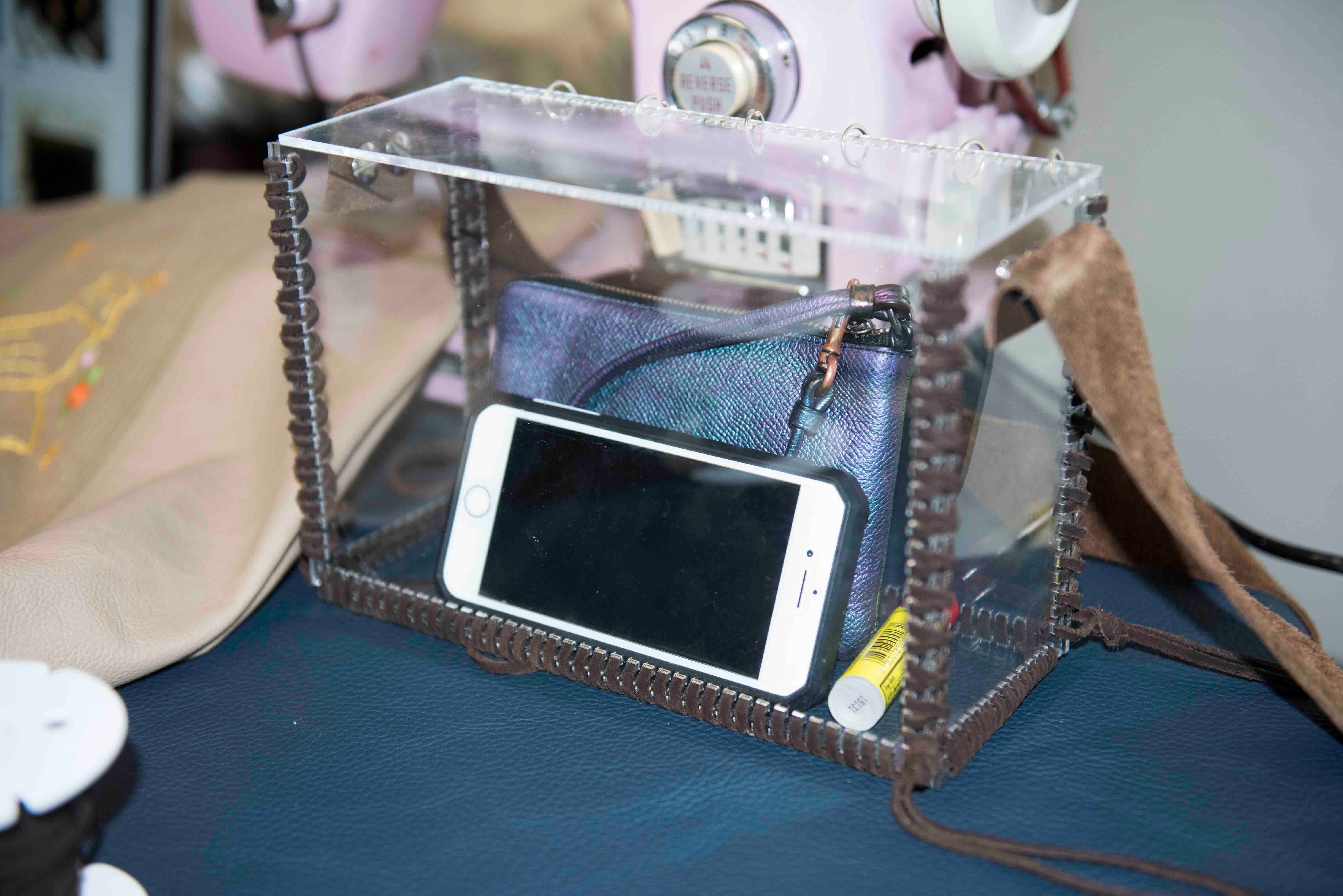
How do you deal with problems and challenges that arise during your process?
It can get kind of discouraging because I see a lot of kids around here who want to start a streetwear brand, and then they create a logo on the computer and screen-print a million t-shirts. So when I had higher end things, it’s obviously not a budget for students. But in the grand scheme of things, those are the people who are going to taper off, they’ll get bored and they clearly don’t have a lot of creativity so they plateau. The people that really make it into the industry are people with new ideas and have legitimate work ethic, so that’s what keeps me going. I think it’s part of the bubble that I live in. But my aunt and uncle bought some of my bags and handed me cash. They’re from New York and they have a different demographic and market. Moms love my bags.
I also don’t have the professional equipment for leather making—no industrial machines or anything like that. A lot of stuff I do by hand, and then a lot a sew on my machine, but it’s not a perfect system. I break a lot of needles.
What's coming up next for you?
This year I really want to get better at product photography. I want to research suppliers because I think the way I’m doing it right now is not efficient to get my necessary supplies. My leather is good and pretty cheap, but the hardware is so expensive. I use coupons and things and it’s still too much for me. And I want to be more of a household name. I want to see someone carrying my bag on campus and see my friends excited about the things I post online. And I want to see myself participating in more in-person sales events.



